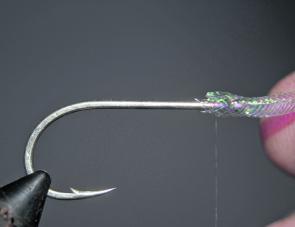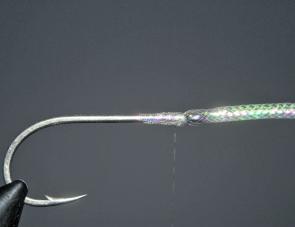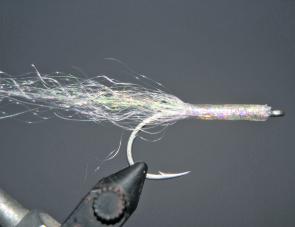With an influx of bait species entering Moreton Bay and other waters along the east coast over the following months, anglers would be wise to have plenty of baitfish profiled flies in their kit.
During early summer the baitfish species are relatively miniscule and virtually clear. The most prominent feature is always the eye, because baitfish this small are too immature to have any other discernible features. The Mylar Spratt is a good representation of this bait and is definitely a worthwhile addition to your fly selection.
The juvenile and virtually transparent baitfish that are prominent throughout Moreton Bay and other inshore waters during the warmer months are often the focus of many pelagics and some demersal species. While many of these will opportunistically feed on any baitfish that happens by, some get focussed on the major baitfish source and will only eat exact replicas of this bait.
Longtail tuna are one such species that can be profile pedantic and at times even the large longtails in excess of 15kg will only gorge on tiny baitfish, which can be less than 2cm in length at times. They seem to have tunnel vision and will refuse any larger baitfish or flies unless they are exactly the same size as the majority of the bait in the school.
For the average angler this poses a problem. There are very few plastics or other lures that are this small or that imitate the baitfish accurately. Likewise, delivering an offering this small is near to impossible. If you did find a rod that was light enough to load up and cast such a small offering, it would not be heavy enough in action to be able to land a larger pelagic. In this situation the fly fisher has a serious advantage over conventional lure casting methods.
Fly fishers are able to deliver small, virtually weightless offerings good distances; often in excess of 30m if you are a decent caster as they are casting the line, not the weight on the end. Fly fishers can often tempt profile orientated species when all others cannot deliver a suitable offering the require distance.
The materials list for the Mylar Spratt is relatively minimal. The hook pattern I have used is the Mustad C70S D however the Gamakatsu SL12S and most O’Shaunnessy patterns would also be suitable.
The tail is made with Slinky Fibre Steve Farrar Blend, a material made from a combination of Slinky Fibre and Lite Brite (aka Angel Hair or Microflash). This transparent, errant and flashy material is ideal for a broad array of baitfish flies and is often used as the only body material in some patterns. Standard Slinky Fibre brands, Streamer Hair, Neer Hair and various flash materials could also be used.
The main body is formed using mylar tube. The size used will depend on what hook size you are tying on, however as we are using a 1/0 today then I have opted for the ‘small’ which will only just fit. However, you need to be careful of how much Slinky Fibre you use otherwise the mylar tube will not roll back over it.
We are coating the fly with epoxy to add to the visual appeal as well as the durability. Standard 5-minute epoxy can be used however this will increase your tying time and you will require an epoxy rotator to put the fly on while it dries so the epoxy doesn’t sag to one side. The Loon UV Epoxy (sold as Wader Repair or Knot Sense) allows you to instantly dry the pattern by placing it under a UV (black) light or exposing it to the sun’s rays. This makes the whole task a lot easier and quicker.
Various styles and colours of eyes could be used however I have a preference for the glow-in-the-dark, flat, self-adhesive type for most of my baitfish patterns.
(1) Place the hook securely in the vice and attach the thread with a jamb knot just behind the hook eye. Cut a length of mylar tube that is approximately as long as the entire hook. Remove the inner material and discard so you are now only left with the outer portion. Place this over the hook eye to check that it will fit comfortably as different brands may be slightly different sizes.
(2) Push the mylar tube a few millimetres over the hook eye and the use thread wraps to secure it in place. Wrap the thread forward until you have secured the Mylar Tube right up to the hook eye.
(3) Take a small portion of the Slinky Fibre that is approximately twice the length of the hook and tie in at this point. You must be careful to not use too much material as it can make the next step difficult if you do. Whip finish and remove the extra thread.
(4) Push the mylar tube backwards so that it inverts and rolls over the hook eye and Slinky Fibre. Adjust so that it is fairly even and smooth all the way along. The end fibres will fray somewhat but we will remove these later.
(5) Cover the mylar tube with a coating of epoxy down to where it starts to fray. Make sure it is a fairly even coating before putting the fly under the UV light to instantly set the epoxy. Using the points of your scissors, remove the frayed strands of mylar until you have a neat finish.
(6) Place an adhesive eye onto each side of the pattern and then apply another even coat of epoxy. Once satisfied that it is even, place under the UV light to instantly set. Ensure you turn the fly on various angles to set all the epoxy. As UV epoxy can sometimes get a little tacky in wet or humid conditions, I also add a coat of clear nail lacquer to ensure a hard and shiny finish.
Your Mylar Spratt is now ready to tempt even the fussiest and most pedantic pelagics, as well as numerous other species.
MATERIALS
| HOOK: | Mustad C70S D 1/0 |
|---|---|
| THREAD: | Mono, fine |
| BODY: | Mylar tube, small pearl |
| TAIL: | Slinky Fibre Steve Farrer Blend, white |
| EYE: | Self-adhesive, 1.5mm glow-in-the-dark |
| FINISH: | Loon UV Epoxy |










